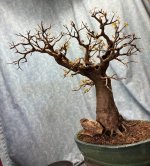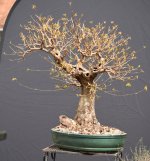Can't see the nebari so can't comment on whether it's OK or not but there are several possible paths to improve nebari on trident maple. You just need to add 5-10 years to the project.
I don't think the scars are too bad and not unexpected in field grown tridents. On the plus side, tridents do heal relatively quickly. During the root and branch development time you could have most of those healed.
Wondering what you hope to achieve by hedge pruning? It is a technique to control growth but does not do much for developing good branching and any pruning at this stage will slow down wound healing and root development. Hedge pruning tends to develop thick and awkward branching so you will need to do some occasional selective pruning to make sure you don't actually ruin what you already have.
I'd be making a plan for development, step by step. maybe concentrate on getting the wounds closed and some better roots first. That could take the next 4-5 years depending on your growing conditions and experience.
It may be possible to start some primary branching during the first phase but often the rampant growth used to heal wounds and develop new roots is not suitable for final branches. At some stage you'll need to select and position some primary branching, usually using young, flexible shoots. When set in position, they then need to grow to thicken - more growth but a little restrained this time. After that comes grow and chop over several years to develop secondary and tertiary ramification.
Good luck with this one. I think it has more potential than many other field grown tridents I've seen posted here.









